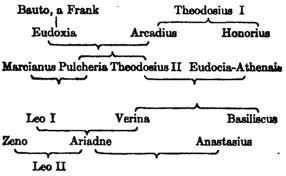|
The accession of Honorius and Arcadius was marked by a basic change in the role of the emperor. It affected east and west differently, and what happened is of major importance in comprehending what occurred subsequently in the two halves of the empire. Roman emperors after Theodosius were heads of state but no longer held effective power. This now fell into the hands of their chief ministers. The change was complete in the west, but less so in the east where occasional emperors still took direct command.

The Byzantine Empire was ruled by a number of dynasties. Below are a few of them-
The history of the Macedonian dynasty falls into two periods, unequal in significance and duration. The first period extends from 867 to 1025, the year of the death of Emperor Basil II; the second, the brief period from 1025 to 1056, when Empress Theodora, the last member of this dynasty, died.

Dynasties of Roman Emperors - Crisis of the Third Century (235 - 284)
The Crisis of the Third Century was the period in Roman history following the death of Alexander Severus when Rome entered into the era of Military Anarchy commonly known as the Crisis of the Third Century.
During the Crisis of the Third Century, lasting over 50 years, not one single Emperor died of natural causes. Revolts sprung up in virtually all of the provinces and ambitious men struggled for power. During the crisis there were civil wars, street fights between the citizens of Rome and soldiers of the imperial guard, fierce foreign enemies, plagues, famines, fire and earthquakes.

Of the emperors of this period, Arcadius (395-408) and Theodosius II (408-50) received the throne by right of inheritance. The old senator Marcanius (450-57) came to the throne through his marriage with the sister of Theodosius II, Pulcheria who for years previously had been an inmate of a convent.
The Thracian Leo I the Great (457-74), owed his power to Aspar the Alan, Magister Militum per Orientem, who, as an Arian, was debarred from the imperial dignity, and who therefore installed the orthodox Leo. Leo, it is true, soon became refractory, and in 471 Aspar was executed by imperial command. On Leo's death the throne was transmitted through his daughter Ariadne, who had been united in marriage to the leader of the Isaurian bodyguard, and had a son by him, Leo II.
Dynasty of the Angeli
The capture of Constantinople was the Fourth Crusade's 'success', and Latin emperors were established in the city. The Byzantines withdrew to Nicæa in Anatolia, but rival claimants also established holdings in Trebizond and Epirus so that, at one point, there were four claimants to the Byzantine throne, as well as the Bulgar and Serb states.
Dynasties of Roman Emperors - Eastern Empire (Byzantine)
The Empire was to live on in the east for many centuries although it was significantly reduced in size. It became an essentially regional power which was centered on Greece and Anatolia. This medieval stage of the Roman Empire is referred to as the Byzantine Empire
Dynasty of Heraclius
Following growing discontent with the emperor, the exarch of Ravenna, Eleutherius, noted the emperor's focus was on fighting the Sassanids and took the opportunity to declare himself emperor. In 620 he marched on Rome, with an intention of making it his capital, but he was murdered by his own troops.
Around 623 – 628 A.D. Heraclius attacked the Persians to regain territory including Syria and Palestine which has been lost for a decade. His campaigns also returned Armenia to Byzantine control.
|

![]()


